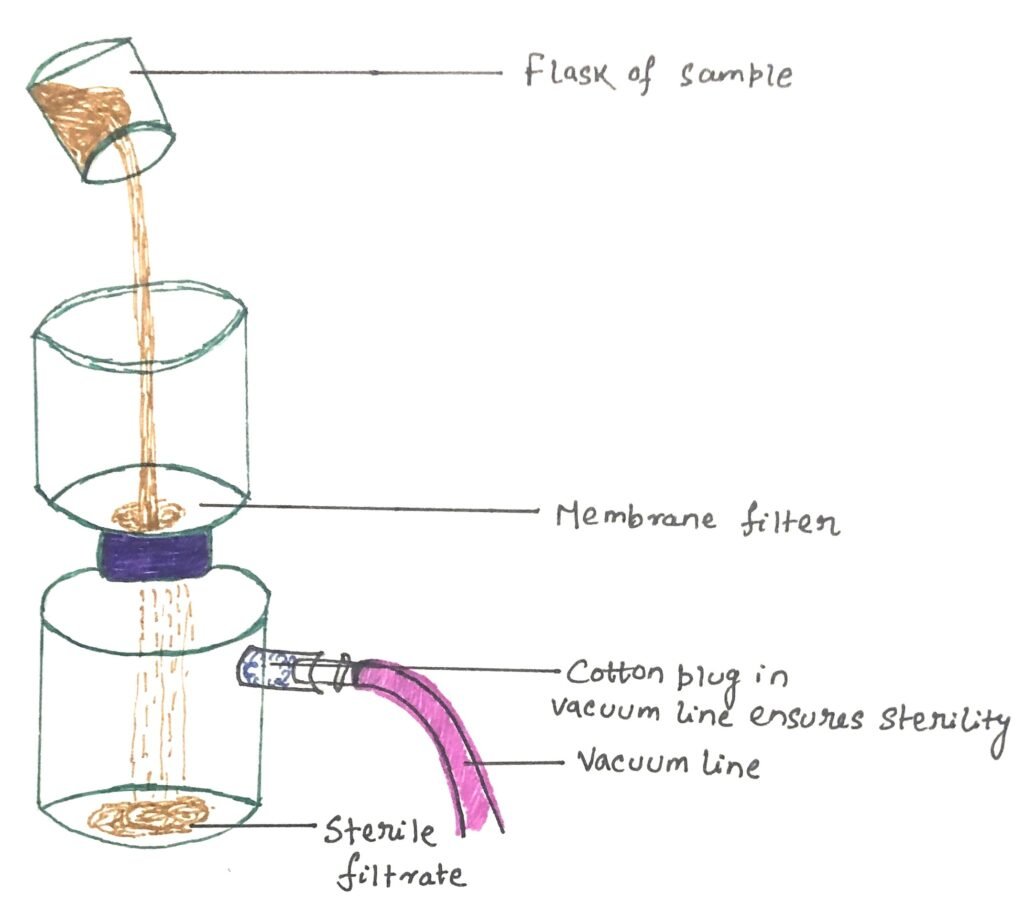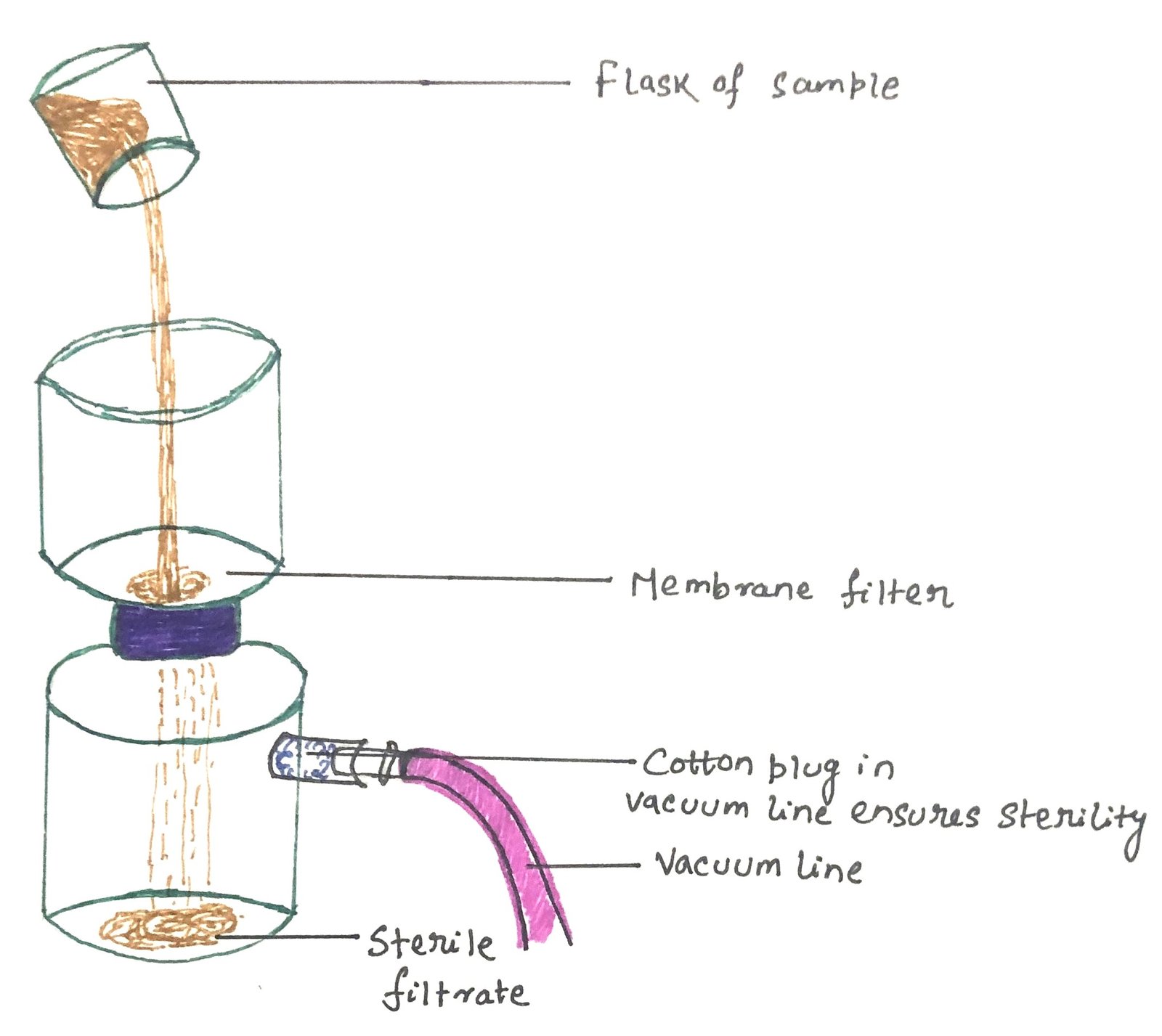In this article, I briefly describe how desiccation, filtration, osmotic pressure, and radiation control microorganisms.
Physical Methods of Microbial Control
It is necessary to control microorganisms for the prevention of diseases. Microbial growth is controlled either by killing microorganisms or by inhibiting their growth of microorganisms. Microorganisms are generally controlled by the use of physical agents and chemical agents.
Different species of microorganisms differ in their susceptibility to physical and chemical agents. Bacterial spores are the most resistant of all living organisms in their capacity to survive under adverse physical and chemical conditions.
Desiccation and Lyophilization
Desiccation, or drying, has been used for thousands of years to preserve foods. Drying evaporates water and inhibits microbial growth by hindering their metabolism. Desiccation of the microbial cell causes a cessation of metabolic activity, followed by a decline in the total viable population. After desiccation, the survival time of microorganisms varies, which depends on various factors. The factors include the kind of microorganisms, the material on which the organisms are dried, the fulfillment of the drying process, and the physical conditions to which the dried organisms are exposed.
Bacterial species of Gram-negative cocci, such as gonococci and meningococci, are very sensitive to desiccation. They die within hours, whereas Streptococci are much more resistant, as some survive weeks after being dried. Dried spores of microorganisms are known to remain viable indefinitely.
Lyophilization, or freeze-drying, preserves microbes and other cells for many years. The process freezes a culture in liquid nitrogen and removes the remaining water through a vacuum. The freezing process prevents the formation of large, damaging ice crystals. Thus, it leaves enough viable cells to enable the culture to be reconstituted after many years. Lyophilization is useful in storing a bacterial culture in the laboratory for research purposes.
Filtration
Filtration is the passage of air or a liquid through a material that traps microbes (figure 1). It is used to sterilize heat-labile liquids and gases. These filters are made of different materials. These biological filters have pores of different sizes. Other than porosity, various other factors can influence the efficiency of filtration. The factors influencing the efficiency are the electric charge of the filter, the electric charge carried by the organism, and the nature of the fluid being filtered.

At present, a new type of filter called a membrane or molecular filter is used, whose pores are of uniform and specific predetermined size. These membrane filters are composed of biologically inert cellulose esters and contain millions of microscopic pores of very uniform diameter. Membrane filters made up of nitrocellulose or plastic have small pores, which can’t trap the smallest viruses and some large protein molecules. These filters are used extensively in the laboratory and in the industry to sterilize fluid materials. The fluid is normally forced through the filter by applying a negative pressure to the filter flask by use of a vacuum or a water pump to impose a positive pressure above the fluid in the filter chamber, thus forcing it through. After filtration is complete, the transfer of filtered material to other containers is done carefully to prevent contamination.
The high-efficiency particulate air (HEPA) filters remove microbes and particles from the air and deliver clean air. This type of air filtration, together with a system of laminar airflow, is now used to produce dust and bacteria-free air.
Osmotic Pressure
When cells are kept in a higher solute concentration, water will be drawn out of the cell, a process called plasmolysis. The reverse process in which the passage of water from a low solute concentration takes place into the cells is called plasmoptysis. The pressure built up within the cell as a result of this water intake is termed osmotic pressure.
Plasmolysis results in dehydration of the cell, as a consequence of which metabolic processes are retarded partially or completely. Microbial cells have high rigidity, and due to this the cell wall doesn’t exhibit distortions as a result of plasmolysis. However, protoplast shrinks and changes in the cytoplasmic membrane can be observed during plasmolysis.
High concentrations of salt or sugar inhibit microbial growth by osmotic pressure. Hyperosmotic conditions help preserve food. They cause water to be drawn out of bacteria and fungi so that they cannot thrive. Jam and pickles are loaded with high solute concentration and this makes them hyperosmotic to the cytoplasm of bacteria and fungi. This forces water to leave the cells by osmosis. However, some microbes (some yeasts in brine pickles, or surface molds in jam) do grow in hyperosmotic conditions.
Radiation
It is the process of transmission of energy through space in a variety of forms. Electromagnetic radiation is the most significant one, which has the dual properties of a continuous wave phenomenon and a discontinuous particle phenomenon. The particles are quanta of energy called photons, which vibrate at different frequencies.
Ionizing radiations have energies of more than 10eV. Gamma rays and X-rays are ionizing radiations, which have enough energy to knock electrons away from molecules and ionize them. When such radiations pass through cells, they create free hydrogen radicals, hydroxyl radicals, and some peroxides, which in turn can cause different kinds of intracellular damage.
X-rays and Gamma rays
These rays are an effective means of killing microbes. X-rays have considerable energy and penetration ability. However, they are expensive and difficult to utilize efficiently.
Gamma rays are high-energy radiations emitted from certain radioactive isotopes such as 60Co. Gamma rays are of shorter wavelength and higher energy than X-rays. These rays have greater penetrating power into the matter, and they are lethal to all forms of life. X-rays and gamma rays, in particular, are used to sterilize foods such as those used by astronauts or in packaged foods for the armed forces.
Results of quantitative studies on the effect of ionizing radiation on the cells have resulted in the establishment of the ”target” theory of action. According to the theory, the radiant energy particle makes direct heat on some essential substance such as DNA within the bacterial cell, causing ionization, which results in the death of the cell.
Conclusion
Microorganisms are generally controlled by the use of physical agents and chemical agents. Desiccation of the microbial cell causes a cessation of metabolic activity, followed by a decline in the total viable population. Lyophilization, or freeze-drying, preserves microbes and other cells for many years. The process freezes a culture in liquid nitrogen and removes the remaining water through a vacuum.
Filtration is used to sterilize heat-labile liquids and gases. Membrane filters made up of nitrocellulose or plastic have small pores, which can’t trap the smallest viruses and some large protein molecules. Membrane filters are made up of nitrocellulose or plastic and have small pores. These are used extensively in the laboratory and in the industry to sterilize fluid materials. Due to the small pores, these filters can’t trap the smallest virus molecules and some large protein molecules. The high-efficiency particulate air (HEPA) filters remove microbes and particles from the air and deliver clean air.
High concentrations of salt or sugar inhibit microbial growth by osmotic pressure. Hyperosmotic conditions help preserve food. They cause water to be drawn out of bacteria and fungi so that they cannot thrive. X-rays and gamma rays, in particular, are used to sterilize foods such as those used by astronauts or in packaged foods for the armed forces. According to the target theory, the radiant energy particle makes direct heat on DNA within a bacterial cell, causing ionization, which results in the death of the cell.
You may also like:
- Temperature controls microbial growth
- Antibiotics inhibit cell wall synthesis of microorganisms
- The Importance of Aquatic Microbial Ecosystems

I, Swagatika Sahu (author of this website), have done my master’s in Biotechnology. I have around fourteen years of experience in writing and believe that writing is a great way to share knowledge. I hope the articles on the website will help users in enhancing their intellect in Biotechnology.




